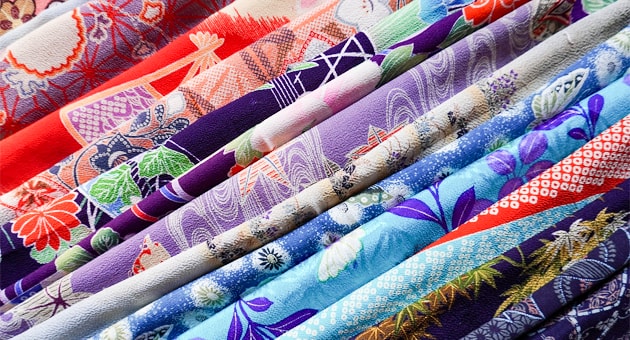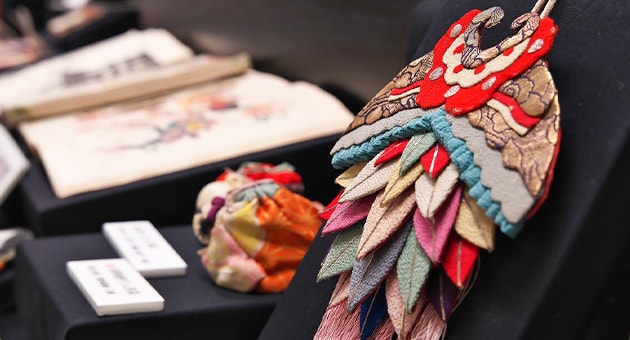その歴史 - History
縮緬(ちりめん)は細やかな「しぼ」をもつ優しい絹織物で、日本の着物の材料として古くから愛好されてきました。
江戸時代の後半、貴族社会や武家の女性、また裕福な商家の女性によって、着物を裁った後の残り布を利用して、美しい袋物や小箱などが作られるようになりました。
人形や動物、花などをかたどったそれらの袋物や小箱を、今日、「ちりめん細工」と呼んでいます。
ちりめん細工は残り布を大切にする心、美的感覚、手先の器用さなどを身につける手芸で、日本女性の教養の一つでもありました。

その変遷 - Transition
明治時代に入ると、ちりめん細工は女学生の教材として取り上げられ、女学生達は、『女学裁縫教授書 ( 明治27年 ) 』『裁縫おさいくもの(明治42年)』『続裁縫おさいくもの(明治45年)』などを教科書として、意匠をこらした作品づくりを競い合いました。
花や動物の袋物は香入れや琴爪入れに、玩具や人形の袋物は子どもの御守りにも使用されたようです。

再興と普及活動 - Revitalization and Dissemination Activities
こうして作り継がれてきたちりめん細工ですが、戦争による世の中の混乱や生活様式の変化の中で、いつしか忘れられた存在となりました。
日本玩具博物館は、ちりめん細工が伝える世界の素晴らしさに気付き、1986年より古作品や文献資料の収集を行い、また博物館活動の一環として、展示会や講習会を開催して復興と普及に努めてきました。
常設展では、江戸時代から明治・大正時代にかけての古作品と当館の復興活動を通して今によみがえった平成のちりめん細工を季節ごとに分け、和の伝統手芸の世界をご紹介しています。日本女性が育み伝えてきた美意識や針仕事の温かさをお伝えできれば幸いです。

History
Chirimen is a silk fabric with a smooth, bumpy texture that has been a beloved material used in Japanese kimonos for ages. In the latter half of the Edo period, women of the aristocracy and samurai families as well as women from prosperous merchant families took scraps of the material leftover from kimono making and used them to create beautiful purses and small pouches. These small bags and pouches, which take on the shape of dolls, animals, and flowers, are known as chirimen crafts.
Chirimen crafts was one of the ways for Japanese women to show how educated and cultured they were as it requires heart to value leftover fabric, sense of beauty, and hand dexterity.
Transition
During the Meiji period, chirimen crafts were taught to school girls, who used sewing craft books“Saihou Osaiku Mono” (1909) and “Zokusaihou Osaiku Mono” (1912) a textbooks and competed to see who could create the most elaborately designed pieces. It appears that the pouches shaped like flowers and animals were used to store incense and koto plectrums, while the toy and doll pouches were used as protective charms for children.
Revitalization and Dissemination Activities
After being passed down this way through the years, the Chirimen craft was forgotten in the wake of World War Two, which altered the way many people lived including the westernization of clothing. The Japan Toy Museum took notice of the amazing history of Chirimen crafts and has been collecting old pieces and documentation on the art since 1986. One of our undertakings is to revive and popularize this craft through our exhibits and classes.
The permanent exhibition of the museum introduces the world of Japanese traditional handicrafts. It includes both the old Chirimen crafts from the Edo period through the Meiji and Taisho periods and the crafts that have been made in our building from our revival efforts, which are from the Heisei period (1989 to 2019). Moreover, they are displayed by seasons. We hope the exhibition communicates the warm sense of aesthetics and needlework that has been cultivated and passed down by the women of Japan.




